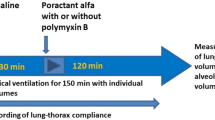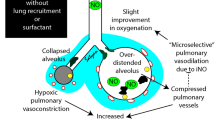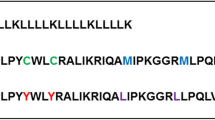Abstract
A disease similar to acute respiratory distress syndrome may occur in neonates after aspiration of meconium. The aim of the study was to compare the inhibitory effects of human meconium on the following surfactant preparations suspended at a concentration of 2.5 mg/mL: Curosurf, Alveofact, Survanta, Exosurf, Pumactant, rabbit natural surfactant from bronchoalveolar lavage, and two synthetic surfactants based on recombinant surfactant protein-C (Venticute) or a leucine/lysine polypeptide. Minimum surface tension, determined with a pulsating bubble surfactometer, was increased >10 mN/m at meconium concentrations ≥0.04 mg/mL for Curosurf, Alveofact, or Survanta, ≥0.32 mg/mL for recombinant surfactant protein-C, ≥1.25 mg/mL for leucine/lysine polypeptide, and ≥20 mg/mL for rabbit natural surfactant. The protein-free synthetic surfactants Exosurf and Pumactant did not reach minimum surface tension <10 mN/m even in the absence of meconium. We conclude that surfactant activity is inhibited by meconium in a dose-dependent manner. Recombinant surfactant protein-C and leucine/lysine polypeptide surfactant were more resistant to inhibition than the modified natural surfactants Curosurf, Alveofact, or Survanta but less resistant than natural lavage surfactant containing surfactant protein-A. We speculate that recombinant hydrophobic surfactant proteins or synthetic analogs of these proteins can be used for the design of new surfactant preparations that are relatively resistant to inactivation and therefore suitable for treatment of acute respiratory distress syndrome.
Similar content being viewed by others
Log in or create a free account to read this content
Gain free access to this article, as well as selected content from this journal and more on nature.com
or
Abbreviations
- (A)RDS:
-
(acute)respiratory distress syndrome
- MAS:
-
meconium aspiration syndrome
- SP:
-
surfactant protein
- rSP-C:
-
recombinant surfactant protein C
- KL4:
-
SP-B–like peptide
- FFA:
-
free fatty acids
- DPPC:
-
dipalmitoylphosphatidylcholine
- PG:
-
phosphatidylglycerol
References
Jobe AH 1993 Pulmonary surfactant therapy. N Engl J Med 328: 861–868
Fuchimukai T, Fujiwara T, Takahashi A, Enhorning G 1987 Artificial pulmonary surfactant inhibited by proteins. J Appl Physiol 62: 429–437
Seeger W, Stöhr G, Wolf HRD, Heuhof H 1985 Alteration of surfactant function due to protein leakage: special interaction with fibrin monomer. J Appl Physiol 58: 326–338
Holm BA 1993 Surfactant inactivation in the adult respiratory distress syndrome. In: Robertson B, van Golde LMG, Batenburg JJ (eds) Pulmonary surfactant: from molecular biology to clinical practice. Elsevier, Amsterdam, 665–684.
Walmrath D, Günther A, Ghofrani HA, Schermuly R, Schneider T, Grimminger F, Seeger W 1996 Bronchoscopic surfactant administration in patients with severe adult respiratory distress syndrome and sepsis. Am J Respir Crit Care Med 154: 57–62
Robertson B 1998 Surfactant inactivation and surfactant therapy in acute respiratory distress syndrome (ARDS). Monaldi Arch Chest Dis 53: 64–69
Holm BA, Waring AJ 1993 Designer surfactants: the next generation in surfactant replacement. Clin Perinatol 20: 813–829
Wiswell TE, Tuggle JM, Turner BS 1990 Meconium aspiration syndrome: have we made a difference?. Pediatrics 85: 715–721
Cleary GM, Wiswell TE 1998 Meconium-stained amniotic fluid and the meconium aspiration syndrome. Pediatr Clin North Am 45: 511–529
Wiswell TE, Gannon CM, Jacob J, Goldsmith L, Szyld E, Weiss K, Schutzmann D, Cleary GM, Filipov P, Kurlat I, Caballero CL, Abassi S, Sprague D, Oltorf C, Padula M 2000 Delivery room management of the apparently vigorous meconium-stained neonate: results of the multicenter, international collaborative trial. Pediatrics 105: 1–7
Moses D, Holm BA, Spitale P, Liu MY, Enhorning G 1991 Inhibition of pulmonary surfactant function by meconium. Am J Obstet Gynecol 164: 477–481
Sun B, Curstedt T, Robertson B 1993 Surfactant inhibition in experimental meconium aspiration. Acta Paediatr 82: 182–189
Davey AM, Becker JD, Davis JM 1993 Meconium aspiration syndrome: physiological and inflammatory changes in a newborn piglet model. Pediatr Pulmonol 16: 101–108
Wright JR 1997 Immunomodulatory functions of surfactant. Physiol Rev 77: 931–962
Sun B, Herting E, Curstedt T, Robertson B 1994 Exogenous surfactant improves lung compliance and oxygenation in adult rats with meconium aspiration. J Appl Physiol 77: 1961–1971
Paranka MS, Walsh WF, Stancombe BB 1992 Surfactant lavage in a piglet model of meconium aspiration syndrome. Pediatr Res 31: 625–628
Auten RL, Notter RH, Kendig JW, Davis JM, Shapiro DL 1991 Surfactant treatment of full-term newborns with respiratory failure. Pediatrics 87: 101–107
Khammash H, Perlman M, Wojtulewicz J, Dunn M 1993 Surfactant therapy in full-term neonates with severe respiratory failure. Pediatrics 92: 135–139
Halliday HL, Speer CP, Robertson B 1996 Treatment of severe meconium aspiration syndrome with porcine surfactant. Eur J Pediatr 155: 1047–1051
Lotze A, Mitchell BR, Bulas DI, Zola EM, Shalwitz RA, Gunkel JH 1998 Multicenter study of surfactant (Beractant) use in the treatment of term infants with severe respiratory failure: Survanta in Term Infants Study Group. J Pediatr 132: 40–47
Findlay RD, Taeusch HW, Walther FJ 1996 Surfactant replacement therapy for meconium aspiration syndrome. Pediatrics 97: 48–52
Enhorning G, Shumel B, Keicher L, Sokolowski J, Holm BA 1992 Phospholipases introduced into the hypophase affect the surfactant film outlining a bubble. J Appl Physiol 73: 941–945
Kobayashi T, Robertson B 1983 Surface adsorption of pulmonary surfactant in relation to bulk phase concentration and presence of CaCl2 . Respiration 44: 63–70
Johansson J, Curstedt T, Robertson B 1994 The proteins of the surfactant system. Eur Respir J 7: 372–391
Revak S, Merritt TA, Hallman M, Cochrane C 1986 Reconstitution of surfactant activity using purified human apoprotein and phospholipids measured in vitro and in vivo. Am Rev Respir Dis 134: 1258–1265
Nilsson G, Gustafsson M, Vandenbussche G, Veldhuizen E, Griffiths WJ, Sjövall J, Haagsman HP, Ruysschaert JM, Robertson B, Curstedt T, Johansson J 1998 Synthetic peptide-containing surfactants: evaluation of transmembrane versus amphipathic helices and SP-C poly-valyl to poly-leucyl substitution. Eur J Biochem 255: 116–124
Cochrane CG, Revak SD, Merritt TA, Heldt GP, Hallman M, Cunningham MD, Easa D, Pramanik A, Edwards DK, Alberts MS 1996 The efficacy and safety of KL4-surfactant in preterm infants with respiratory distress syndrome. Am J Respir Crit Care Med 153: 404–410
Cochrane CG, Revak SD, Merritt A, Schraufstätter IU, Hoch RC, Henderson CH, Andersson S, Takamori H, Oades ZG 1998 Bronchoalveolar lavage with KL4-surfactant in models of meconium aspiration syndrome. Pediatr Res 44: 705–715
Häfner D, Germann PG, Hauschke D 1998 Effects of rSP-C surfactant on oxygenation and histology in a rat-lung-lavage model of acute lung injury. Am J Respir Crit Care Med 158: 270–278
Spragg RG, Lewis J, Wurst W, Rathgeb F 2000 Treatment of ARDS with rSP-C surfactant. Am J Respir Crit Care Med 161: A47( abstr)
Wauer R 1998 Respiratory distress syndrome. In: Wauer RR (ed) Surfactant therapy: basic principles, diagnosis, therapy. Thieme, Stuttgart, 2–19.
Seeger W, Grube C, Günther A, Schmidt R 1993 Surfactant inhibition by plasma proteins: differential sensitivity of various surfactant preparations. Eur Respir J 6: 971–977
Kobayashi T, Shido A, Nitta K, Inui S, Ganzuka M, Robertson B 1990 The critical concentration of surfactant in fetal lung liquid at birth. Respir Physiol 80: 181–192
Amirkhanian JD, Merritt TA 1995 The influence of pH on surface properties of lung surfactants. Lung 173: 243–254
Halliday HL 1995 Overview of clinical trials comparing natural and synthetic surfactants. Biol Neonate 67: 32–47
Jobe AH, Ikegami M 1993 Surfactant metabolism. Clin Perinatol 20: 683–696
Anzueto A, Baughman RP, Guntupalli KK, Weg JG, Wiedemann HP, Raventos AA, Lemaire F, Long W, Zaccardelli DS, Pattishall EN 1996 Aerosolized surfactant in adults with sepsis-induced acute respiratory distress syndrome: Exosurf Acute Respiratory Distress Syndrome Sepsis Study Group. N Engl J Med 334: 1417–1421
Ainsworth SB, Beresford MW, Milligan DWA, Shaw NJ, Matthews JN, Fenton AC, Ward Platt MP 2000 Pumactant and Poractant alfa for treatment of respiratory distress syndrome in neonates born at 25–29 weeks' gestation: a randomised trial. Lancet 355: 1387–1392
Bae CW, Takahashi A, Chida S, Sasaki M 1998 Morphology and function of pulmonary surfactant inhibited by meconium. Pediatr Res 44: 187–191
Günther A, Schmidt R, Feustel A, Meier U, Pucker C, Ermert M, Seeger W 1999 Surfactant subtype conversion is related to loss of surfactant apoprotein B and surface activity in large surfactant aggregates: experimental and clinical studies. Am J Respir Crit Care Med 159: 244–251
Lam BC, Yeung CY 1999 Surfactant lavage for meconium aspiration syndrome: a pilot study. Pediatrics 103: 1014–1018
Wiswell TE, Smith RM, Katz LB, Mastroianni L, Wong DY, Willms D, Heard S, Wilson M, Hite RD, Anzueto A, Revak SD, Cochrane CG 1999 Bronchopulmonary segmental lavage with Surfaxin (KL4-surfactant) for acute respiratory distress syndrome (ARDS). Am J Respir Crit Care Med 160: 1188–1195
Brower RG, Matthay MA, Morris A, Schoenfeld D, Thompson BT 2000 Ventilation with lower tidal volumes as compared with traditional tidal volumes for acute lung injury and the acute respiratory distress syndrome. N Engl J Med 342: 1301–1308
Ware LB, Matthay MA 2000 The acute respiratory distress syndrome. N Engl J Med 342: 1334–1349
Manalo E, Merritt TA, Kheiter A, Amirkhanian J, Cochrane C 1996 Comparative effects of some serum components and proteolytic products of fibrinogen on surface tension-lowering abilities of Beractant and a synthetic peptide containing surfactant KL4. Pediatr Res 39: 947–952
Nogee L, Garnier G, Singer L, Dietz H, Murphy A, Cutting G 1994 A mutation in the surfactant protein B gene responsible for fatal neonatal respiratory disease in multiple kindreds. J Clin Invest 93: 1860–1863
Robertson B, Johansson J, Curstedt T 2000 Synthetic surfactants to treat neonatal lung disease. Mol Med Today 6: 119–124
Weaver TE 1988 Synthesis, processing and secretion of surfactant proteins B and C. Biochim Biophys Acta 1408: 173–179
Botas C, Poulain F, Akiyama J, Brown C, Allen L, Goerke J, Clements J, Carlson E, Gillespie AM, Epstein CH, Hawgood S 1998 Altered surfactant homeostasis and alveolar type II cell morphology in mice lacking surfactant protein D. Proc Natl Acad Sci USA 95: 11869–11874
Mbagwu N, Bruni R, Hernández-Huviel JM, Waring JA, Walther FJ 1999 Sensitivity of synthetic surfactants to albumin inhibition in preterm rabbits. Mol Gen Metabol 66: 40–48
Mizuno K, Ikegami M, Chen CM, Ueda T, Jobe AH 1995 Surfactant protein-B supplementation improves in vivo function of a modified natural surfactant. Pediatr Res 37: 271–276
Cockshutt AM, Weitz J, Possmayer F 1990 Pulmonary surfactant-associated protein A enhances the surface activity of lipid extract surfactant and reverses inhibition by blood proteins in vitro. Biochemistry 29: 8424–8429
Sun B, Curstedt T, Lindgren G, Franzén B, Alaiya AA, Calkovská A, Robertson B 1997 Biophysical and physiological properties of a modified porcine surfactant enriched with surfactant protein A. Eur Respir J 10: 1967–1974
Taeusch W, Lu KL, Goerke J, Clements J 1999 Nonionic polymers reverse inactivation of surfactant by meconium and other substances. Am J Respir Crit Care Med 159: 1391–1395
Tashiro K, Kobayashi T, Robertson B 2000 Dextran reduces surfactant inhibition by meconium. Acta Paediatr 89: 1439–1445
Author information
Authors and Affiliations
Corresponding author
Additional information
Supported by the German Research Council (DFG He 2072/2-2) and a collaborative project (313/S-PPP) of the German Academic Exchange Service (DAAD), the Swedish Research Council (project MFR 3351), and the Swedish Institute (SI).
Rights and permissions
About this article
Cite this article
Herting, E., Rauprich, P., Stichtenoth, G. et al. Resistance of Different Surfactant Preparations to Inactivation by Meconium. Pediatr Res 50, 44–49 (2001). https://doi.org/10.1203/00006450-200107000-00010
Received:
Accepted:
Issue date:
DOI: https://doi.org/10.1203/00006450-200107000-00010
This article is cited by
-
Prevalence and contributing factors of birth asphyxia among the neonates delivered at Nigist Eleni Mohammed memorial teaching hospital, Southern Ethiopia: a cross-sectional study
BMC Pregnancy and Childbirth (2019)
-
Synthetic surfactant with a recombinant surfactant protein C analogue improves lung function and attenuates inflammation in a model of acute respiratory distress syndrome in adult rabbits
Respiratory Research (2019)
-
In vitro and in vivo comparison between poractant alfa and the new generation synthetic surfactant CHF5633
Pediatric Research (2017)
-
Meconium-induced inflammation and surfactant inactivation: specifics of molecular mechanisms
Pediatric Research (2016)



